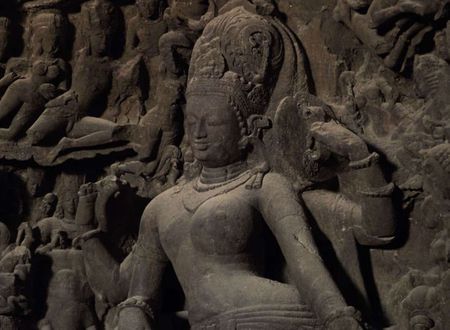Probably the most frequent question I get asked is about my spiritual practices (sadhana)— the actions I take to move my Soul towards freedom (moksha). Maharaj-ji Baba Neem Karoli said, “If you are free of attachment, you will lead a simple life in a simple environment.” and in our home, we strive to follow His instruction.
I’ll be happy to tell you about the disciplines we engage in, but first, I want to relate precisely the spiritual practice that is correct for you.
Many teachers and ‘gurus’ (heavy emphasis on quotes) will tell you their disciplines are the best and only way to the Divine. Bullshit. Every spiritual practice has benefits, and most practices work better for some folks than others. What resonates with you might not be appealing to someone else, and that’s perfectly fine.
The correct spiritual practice for you is one that you enjoy and see incremental benefits with as time progresses. It isn’t supposed to be a chore or a competition with others. You should desire to do it because it’s visibly paying off in your life and relationships.
It should not augment the ego—the practitioner shouldn’t be proud to be better at it than other folks. Maharaj-ji said, “You should not talk about your wealth, wife, or sadhana (spiritual practices), or they will go away.” Sadhana should only be discussed with humility.
Don’t let someone push you into any spiritual practice. Try a bunch of things and see what you enjoy the most. Also, practices are hardly ever for life. Each is a vehicle that we use and (hopefully) discard when its’ usefulness has left us. What resonates with you might change over the years—follow that intuition. The goal isn’t to become good at spiritual practice—the finish line to spirituality is freedom from duality and attachment. The symptoms are self-control, clarity, and harmony with others.
The most important thing is that whatever practice you choose, you follow through and do it without fail. Once a devotee asked Maharaj-ji what mantra he should use, to which Maharaj-ji replied, “The mind can’t concentrate. Use any mantra–use it, use it,” repeated Maharaj-ji. It’s repetitively remembering God, no matter the practice, that brings spiritual maturity.
Both Adri and I share our sadhanas. We don’t just live by a routine in the morning—our entire lives are on schedules and calendars. Our daily practices happen seven days a week. On the weekends, the timing might slide a little, but everything will still occur as planned. We maintain our practices even when we travel as best we can.
I usually wake up around 3:00 am by my internal clock, but our alarm is set for 3:30. Once the alarm sounds, Adri and I have an ‘affirmation’ time together for about fifteen minutes. During this time, we will express our love and commitment to each other and declare specific things we are grateful for in the other person. We’ll also say statements like, “Today is going to be a marvelous day!” or “Maharaj-ji will certainly be with us during every moment today!” When this ends, we make our bed together—even in hotels or especially when staying at someone’s home.
Once we move out of the bedroom, we have a music playlist for the morning that begins with the Hanuman Chalisa by Krishna Das and Lokah Samasta by Deva and Miten.
There are six places in our home that we keep candles lit—a main Maharaj-ji altar that includes small statues of Ganesha, Hanuman, and Guan Yin (representing the divine feminine), a murti of Maharaj-ji, a murti of Hanuman, a murti of Christ, a murti of Sri Yukteswar Giri, and an altar for Siddhi Ma. Twenty-seven candles (9×3) in total are lit for the Masters, followed by several sticks of Nag Champa throughout our dwelling.
Adri has a cup of coffee every morning— I drink a glass of iced tea. We both eat a protein bar. We each take a tablespoon of olive oil and our early morning vitamins. Our study time begins at 4 am but no later than 4:15, specifically to take advantage of the amrit vela. We each study (read) for thirty minutes and then meditate for thirty minutes. Sometimes on the weekend, these times are extended.
We use meditation software called Holosync, developed by an accomplished meditator named Bill Harris with the Centerpointe Research Institute (https://www.centerpointe.com/). I’ve been doing it almost fourteen years now—Adri has been with it for about five years. I could write a book about this—the base of our spiritual growth is never missing meditation. If we miss a day, it could take a week or more to get back to the same states as before we missed. The cumulative effect is tremendous, but a person must sincerely practice meditation to recognize these benefits.
As soon as we finish meditation, we exercise for an hour. Some days are weight training and other times just cardio. I’ve always listened to audiobooks when I worked out. Presently, while on the treadmill or elliptical, I’m listening to all the Ram Dass podcasts in order.
After a quick shower, I have about two hours of uninterrupted work time where I don’t look at texts or emails—I only focus on some project. Head down, working this way, I get more done in that time than most folks accomplish in an entire day of effort. How? Meditation brings focus, and focus multiplies creativity and productivity.
We eat more or less the same breakfast around 8:30 every day, including some combination of eggs, spinach, zucchini, and occasionally vegan beef. We’re pescatarians like Jesus and Ram Dass. We wash the dishes together.
We then work a few hours and eat lunch precisely at noon. We’ve been having the same thing for lunch and dinner for months— a green salad plus some broccoli/cauliflower soup. Sometimes that’s supplemented with a bit of fish for protein. We take our mid-day vitamins.
How do we eat the same meals all the time without getting bored? #1 Utter spiritual gift from Maharaj-ji #2 An amazing benefit of meditation. I really relish the meals every single time. I look forward to how they taste and how they make me feel—the food selection agrees perfectly with my body and my exertion in exercise.
We continue working in the afternoons until about 4 pm. Then we have a few hours to spend together or to work on personal projects. Dinner is at 5:30. We wash the dishes together and prepare everything for the following day. I lay out the vitamins and olive oil. My medallion goes on the altar for recharging. We place our meditation accouterments in the living room. We’re ordinarily in bed by 7:30 and asleep no later than 8:30.
Spiritual music, usually chanting, plays from morning until evening. The candles stay lit on the altars, and incense continues to burn throughout the day. No matter what we are doing, our minds are remembering Maharaj-ji. There are photos of Him in every room and even in the car.
In addition to the murtis mentioned earlier, there are large photos of Govinda and Radha, Shiva and Parvati, Lakshmi, Anandamayi Ma, Rama and Hanuman, Om Swami, Sadhguru, Guru Singh, Mt. Kailash, Ganesha, and Arjuna. There are also small photos of many other upagurus along my path including Yogananda’s lineage, Adyashanti, Gandhi, Dr. Wayne Dyer, and others. Every wall, every direction we look, encourages more bhakti (devotion). Maharaj-ji said to “Remember God in every moment” —this is the best way we’ve found to do it.
Everything in our home has a place. Everything is always in order. There is no clutter. If we aren’t using something, we give it away. Things like the pantry, refrigerator, closets, and drawers are reviewed regularly. There are no ‘junk’ drawers full of crap. Both Adri and I know where to locate what we need when we need it. As my mother would say, we’re “ready for company” at any given moment.
While thinking about living this way, some of you want to throw up in your mouth. I understand that living the same schedule and eating the same meals every day sounds like torture to some people. Two decades ago, I wouldn’t have been able to do it, let alone enjoy it.
Today with my comparatively extreme routine, I’m able to see where my ego remains caught, and therefore, I enjoy it more as it intensifies. If I feel the slightest tinge of boredom with the repetitive nature of anything, that puts a direct spotlight on the ego I still need to tame.
Om Swami meditated twenty-two hours a day for seven months before His vision of the Divine Mother. I’m nowhere close, but I know where I’m headed. Two decades ago, I would have categorized meditation as ‘boring’. However, way back then, as I was leaving organized Christianity, I looked soberly ahead and saw that the people in our world with the most love, clarity, peace, compassion, etc., were meditators. I headed in their direction, and it hasn’t failed me yet.
When I weighed two hundred and ten kilos, it was challenging to walk anywhere. My knees hurt all the time. Nonetheless, I started my weight loss journey by walking five minutes a day, then ten, then thirty, and so on. Five days a week in the gym started many years ago with only five minutes a day. Any small effort that you start now and refuse to quit will pay off big time in your future!
No matter what’s going on in your life right now, adding even a little spiritual structure and discipline will sincerely improve things. If you have some disciplines and practices going regularly, bravo—you know what I’m talking about! Be encouraged to add more! Go further!
If you don’t have any disciplines in your life, start some super small ones and promise yourself that you’ll practice them daily. Ask others to hold you accountable too. I promise the return on your investment will be extreme!
Blessings!
In Christ,
JC
P.S. In this lifetime or a thousand from now, you will become a meditator in order to escape this reality. Why not start now? Om Swami has the Black Lotus app (https://blacklotus.app/), which makes it easy to get going.









Comments & Discussion
40 COMMENTS
Please login to read members' comments and participate in the discussion.